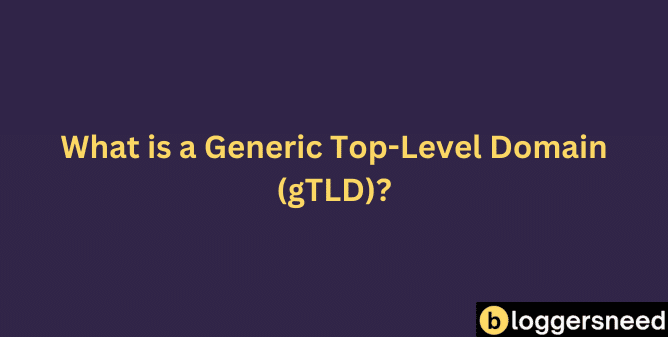
A Generic Top-Level Domain (gTLD) is a category of top-level domain maintained by ICANN, signifying the general purpose of a website, such as ‘.com’, ‘.org’, and ‘.net’. With over 1,600 gTLDs available today, they categorize websites based on their purpose, enhancing visibility and credibility. Introduced in the mid-1980s, the original seven gTLDs included ‘.com’, ‘.org’, ‘.net’, ‘.edu’, ‘.gov’, ‘.mil’, and ‘.int’.
Types of gTLDs include unrestricted (e.g., ‘.com’), sponsored (e.g., ‘.edu’), and generic-restricted (e.g., ‘.name’) options. Choosing the right gTLD can boost brand identity, SEO, and user trust, making it a vital decision for your website’s success. For more detailed information on selecting and utilizing gTLDs, continue exploring this topic.
Table of Contents
What is a Generic Top-Level Domain (gTLD)?
A Generic Top-Level Domain (gTLD) is defined as the last segment of a domain name, following the final dot, and is characterized by its non-specific nature, allowing for broad registration by any individual or organization. gTLDs serve as crucial identifiers in the Domain Name System (DNS), facilitating the categorization and accessibility of websites on the internet. They differ from country code top-level domains (ccTLDs), which are tied to specific geographic locations.
What Is an Example of a gtld?
Examples of generic top-level domains (gTLDs) are common online, and you likely see them daily. These domains are the last part of a web address, coming after the final dot. The most recognizable and widely used gTLDs include .com, .org, and .net. These were among the first seven gTLDs introduced in the 1980s, designed to categorize different types of websites based on their use: .com for commercial entities, .org for non-profit organizations, and .net for network-related services.
Below is a table listing some examples of Generic Top-Level Domains (gTLDs).
| gTLD | Description |
|---|---|
| .com | Commercial entities, businesses, and organizations |
| .org | Non-profit organizations and entities |
| .net | Originally intended for network providers and infrastructure companies |
| .edu | Educational institutions, typically universities and colleges |
| .gov | United States government entities |
| .mil | United States military |
| .info | Information services |
| .biz | Business or commercial use |
| .name | Personal names or individual use |
| .pro | Professionals such as doctors, lawyers, and accountants |
| .coop | Cooperatives |
| .aero | Aviation industry |
| .museum | Museums and related entities |
| .jobs | Employment-related sites |
| .travel | Travel and tourism industry |
| .mobi | Mobile products and services |
| .asia | Regional domain for companies, organizations, and individuals in Asia |
| .cat | Catalan linguistic and cultural community |
| .tel | Internet communication services |
| .xxx | Adult entertainment |
| .app | Apps and developers |
| .blog | Blogs and bloggers |
| .shop | E-commerce and online shopping |
| .site | Generic sites and online spaces |
| .tech | Technology companies and startups |
| .online | General-purpose domain for online presence |
How Many gtlds Are There?
Today, there are over 1,200 gTLDs registered with ICANN. These include both traditional extensions like .biz, .info, and .name, as well as newer, niche options such as .consulting, .art, and .xyz. Originally, there were just seven gTLDs introduced in the 1980s, which included .com, .edu, .gov, .int, .mil, .net, and .org.
However, this number has expanded greatly over the years. In 2010, the Internet Corporation for Assigned Names and Numbers (ICANN) launched a new gTLD program, allowing anyone to apply for their own custom gTLD, provided they could afford the application and registration fees. This move led to a massive increase in the number of available gTLDs.
What Is the History of gTLDs?
The history of Generic Top-Level Domains (gTLDs) dates back to the early days of the Internet. In the mid-1980s, the Internet Engineering Task Force (IETF) introduced the first set of gTLDs through a policy statement, RFC 920. This initial group included seven domains: ‘.com’, ‘.org’, ‘.net’, ‘.edu’, ‘.gov’, ‘.mil’, and ‘.int’.
Each of these domains was intended for a specific type of organization: ‘.com’ for commercial entities, ‘.org’ for non-profit organizations, ‘.net’ for network technologies, ‘.edu’ for educational institutions, ‘.gov’ and ‘.mil’ for U.S. government and military use, respectively.
Over time, the use of these early gTLDs evolved. While ‘.com’, ‘.org’, and ‘.net’ became unrestricted and widely used, others like ‘.edu’, ‘.gov’, and ‘.mil’ remained restricted to specific communities.
What Are the Types of gtlds?
The Generic Top-Level Domains (gTLDs) are categorized into 4 types, each with its own set of use cases and restrictions.
- Unrestricted gTLDs: These gTLDs are open for registration by anyone. These include popular extensions such as .com, .org, and .net. These domains are versatile and can be used by various types of websites, from commercial entities to non-profit organizations and personal blogs.
- Sponsored gTLDs (sTLDs): sTLDs are restricted to specific communities or organizations. Examples include .edu, which is intended for educational institutions, and .gov, which is for U.S. government entities. These domains are highly regulated and require validation to ascertain compliance with their designated purposes.
- Generic-Restricted gTLDs: Generic-restricted have some limitations on who can register them. For instance, .name is intended for individuals, and .pro is for professionals. These domains serve to maintain a level of credibility by confirming that the registrants meet certain criteria.
- New gTLDs: New gTLDs are introduced as part of ICANN’s expansion program in 2012, resulting in hundreds of new domains such as .app, .shop, and .tech. These domains offer a wide range of options for businesses and individuals looking for more specific and relevant domain extensions.
What Are the Benefits of gtlds?
When you choose a gTLD, you’re not just choosing an extension; you’re gaining several strategic advantages. One of the primary benefits of gTLDs is their global recognition and genuineness. For instance, domains like .com, .net, and .org are universally recognized, which can upgrade your website’s trustworthiness and authority in the eyes of users.
Another considerable advantage is SEO favorability. Many search engines tend to rank .com websites due to their expansive use and frequent searches, which can improve your website’s visibility in search results.
gTLDs also offer flexibility and versatility, allowing them to be used by businesses, organizations, and individuals alike, whatever of their niche or purpose.
Additionally, gTLDs provide a global reach, as they aren’t tied to specific countries or regions, unlike country code top-level domains (ccTLDs). This makes them ideal for businesses or organizations that operate internationally.
What Is the Purpose and Usage of gtlds?
Generic Top-Level Domains (gTLDs) serve as universal identifiers in the Domain Name System (DNS), categorizing websites based on their general purpose or type. These domains help classify the internet by providing a recognizable ending to a website’s address, such as .com, .org, or .net, which signifies the nature of the site without being country-specific.
The primary purpose of gTLDs is to classify websites according to their intended use. For example, .com was originally intended for commercial sites, .org for non-profit organizations, and .net for network-related services. However, these gTLDs have evolved and are now open for registration by anyone, regardless of their original purpose.
gTLDs are widely used because they offer global recognition and are easily memorable. The most popular gTLDs, such as .com, .net, and .org, are highly sought after due to their familiarity and trustworthiness. They enhance brand identity, improve SEO, and provide credibility to websites.
How Do You Choose the Right gtld?
To choose the right gTLD, start by considering the purpose and target audience of your website. This will help you decide which domain extension best aligns with your needs. For instance, if you’re launching a commercial website, a ‘.com’ or ‘.net’ might be ideal due to their widespread recognition and trust among users.
Consider the type of content you’ll be hosting. For example, if you’re setting up a non-profit or community-focused site, a ‘.org’ could be more fitting.
Newer gTLDs like ‘.blog’, ‘.app’, or ‘.tech’ can provide specificity and help communicate your site’s purpose to visitors, but they may not have the same level of recognition as traditional ones.
Your target audience is also essential. Choose a gTLD that they’re likely to trust and be familiar with. For instance, ‘.com’ is widely recognized and picked by search engines, which can improve your SEO.
Ultimately, select a gTLD that reflects the nature of your site and appeals to your intended users. This careful selection can enhance your website’s credibility and user experience.
What Is the Difference Between a TLD and a gtld?
A top-level domain (TLD) and a generic top-level domain (gTLD) are often used interchangeably, but they’ve distinct differences. A TLD is the final part of a domain name, such as “.com”, “.org”, or “.net”, while a gTLD is a specific category of TLD that isn’t restricted to any geographic or country designation.
TLDs include both generic and country code domains. Generic TLDs, or gTLDs, like “.com”, “.net”, and “.org”, aren’t targeted at any specific country or location, making them universally available for registration. These domains are thematic rather than geographical, indicating the type of organization or purpose of the website.
In contrast, country code TLDs (ccTLDs) are assigned to specific countries, such as “.us” for the United States or “.uk” for the United Kingdom, and are often restricted to residents or entities within those countries.
Understanding these distinctions helps you decide which type of TLD is most suitable for your online presence.
Affiliate Disclosure: Some of the links in this post are affiliate links, which means I may earn a small commission if you make a purchase through those links. This comes at no extra cost to you. Thank you for your support!
